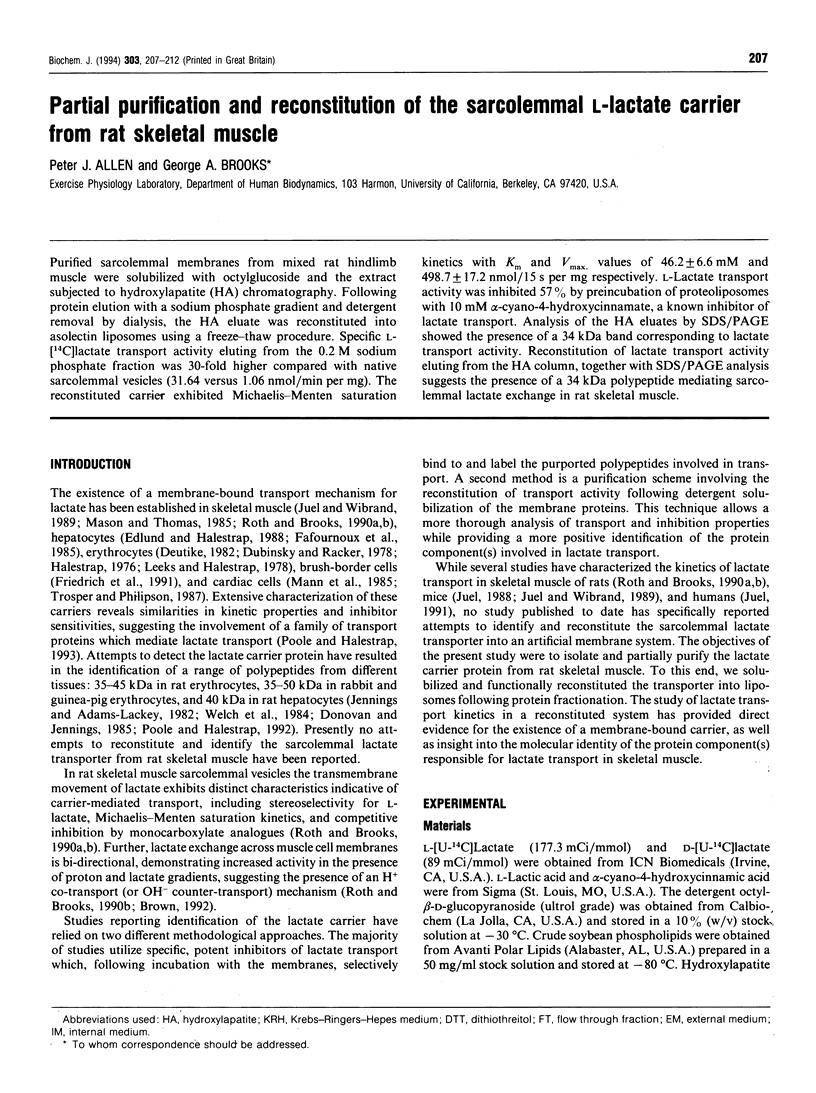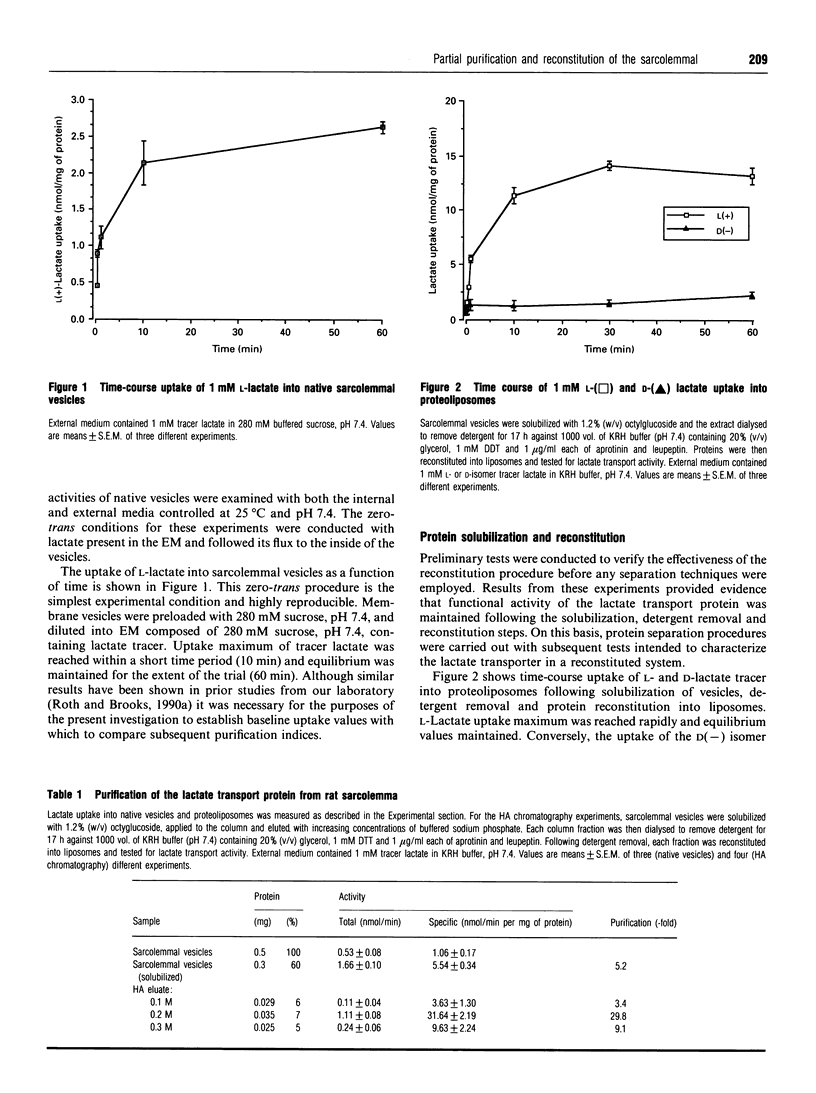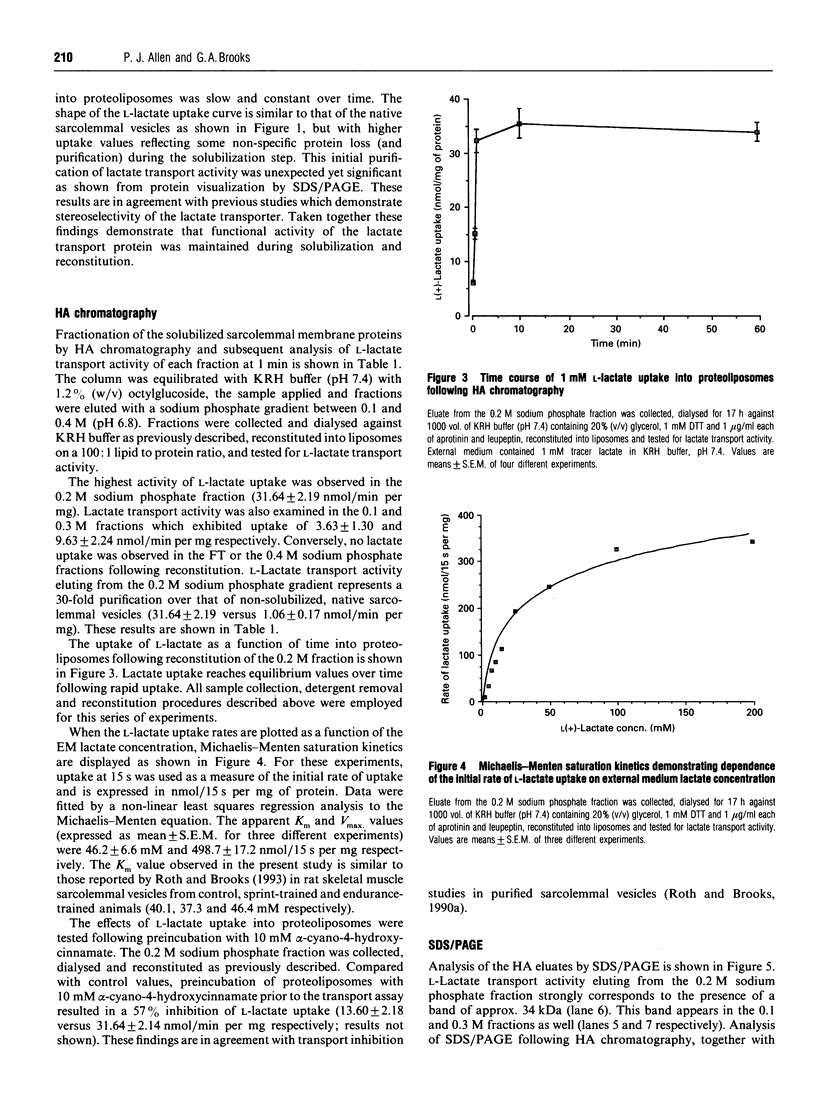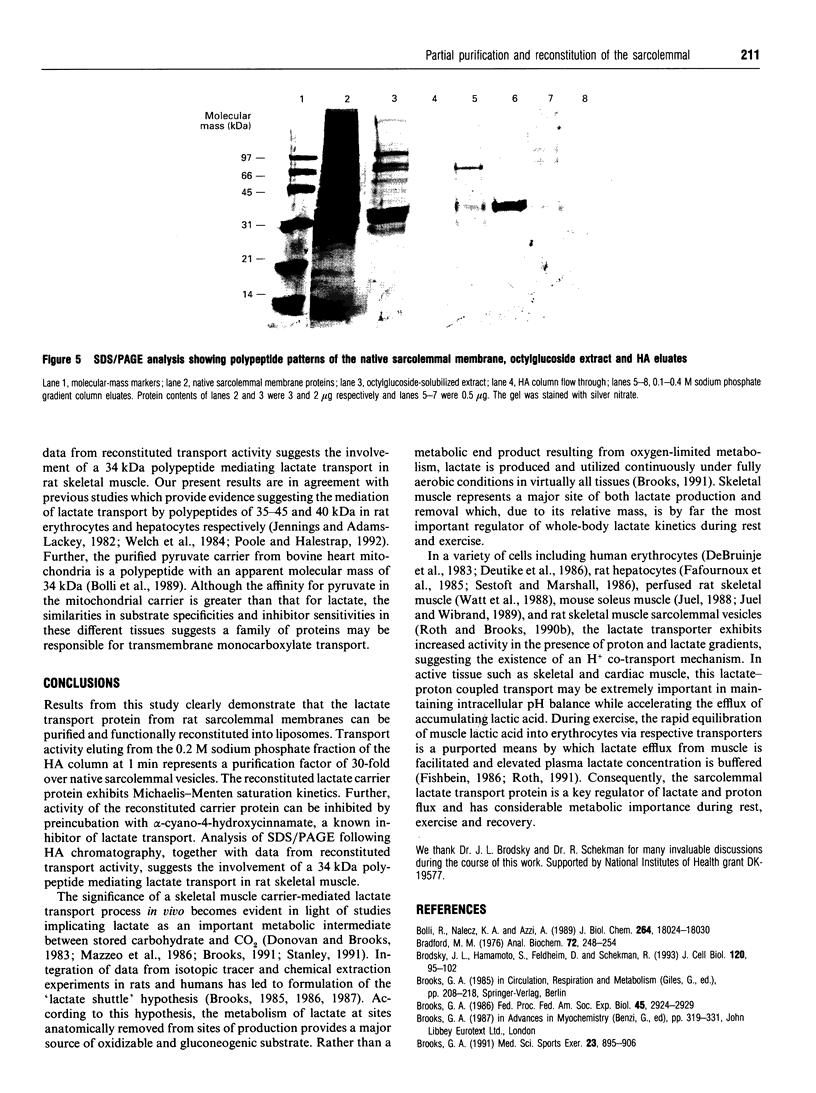Abstract
Purified sarcolemmal membranes from mixed rat hindlimb muscle were solubilized with octylglucoside and the extract subjected to hydroxylapatite (HA) chromatography. Following protein elution with a sodium phosphate gradient and detergent removal by dialysis, the HA eluate was reconstituted into asolectin liposomes using a freeze-thaw procedure. Specific L-[14C]lactate transport activity eluting from the 0.2 M sodium phosphate fraction was 30-fold higher compared with native sarcolemmal vesicles (31.64 versus 1.06 nmol/min per mg). The reconstituted carrier exhibited Michaelis-Menten saturation kinetics with Km and Vmax. values of 46.2 +/- 6.6 mM and 498.7 +/- 17.2 nmol/15 s per mg respectively. L-Lactate transport activity was inhibited 57% by preincubation of proteoliposomes with 10 mM alpha-cyano-4-hydroxycinnamate, a known inhibitor of lactate transport. Analysis of the HA eluates by SDS/PAGE showed the presence of a 34 kDa band corresponding to lactate transport activity. Reconstitution of lactate transport activity eluting from the HA column, together with SDS/PAGE analysis suggests the presence of a 34 kDa polypeptide mediating sarcolemmal lactate exchange in rat skeletal muscle.
Full text
PDF





Images in this article
Selected References
These references are in PubMed. This may not be the complete list of references from this article.
- Bolli R., Nałecz K. A., Azzi A. Monocarboxylate and alpha-ketoglutarate carriers from bovine heart mitochondria. Purification by affinity chromatography on immobilized 2-cyano-4-hydroxycinnamate. J Biol Chem. 1989 Oct 25;264(30):18024–18030. [PubMed] [Google Scholar]
- Bradford M. M. A rapid and sensitive method for the quantitation of microgram quantities of protein utilizing the principle of protein-dye binding. Anal Biochem. 1976 May 7;72:248–254. doi: 10.1006/abio.1976.9999. [DOI] [PubMed] [Google Scholar]
- Brodsky J. L., Hamamoto S., Feldheim D., Schekman R. Reconstitution of protein translocation from solubilized yeast membranes reveals topologically distinct roles for BiP and cytosolic Hsc70. J Cell Biol. 1993 Jan;120(1):95–102. doi: 10.1083/jcb.120.1.95. [DOI] [PMC free article] [PubMed] [Google Scholar]
- Brooks G. A. Current concepts in lactate exchange. Med Sci Sports Exerc. 1991 Aug;23(8):895–906. [PubMed] [Google Scholar]
- Brooks G. A. Lactate production under fully aerobic conditions: the lactate shuttle during rest and exercise. Fed Proc. 1986 Dec;45(13):2924–2929. [PubMed] [Google Scholar]
- De Bruijne A. W., Vreeburg H., Van Steveninck J. Kinetic analysis of L-lactate transport in human erythrocytes via the monocarboxylate-specific carrier system. Biochim Biophys Acta. 1983 Aug 10;732(3):562–568. doi: 10.1016/0005-2736(83)90232-8. [DOI] [PubMed] [Google Scholar]
- Deuticke B., Beyer E., Forst B. Discrimination of three parallel pathways of lactate transport in the human erythrocyte membrane by inhibitors and kinetic properties. Biochim Biophys Acta. 1982 Jan 4;684(1):96–110. doi: 10.1016/0005-2736(82)90053-0. [DOI] [PubMed] [Google Scholar]
- Donovan C. M., Brooks G. A. Endurance training affects lactate clearance, not lactate production. Am J Physiol. 1983 Jan;244(1):E83–E92. doi: 10.1152/ajpendo.1983.244.1.E83. [DOI] [PubMed] [Google Scholar]
- Donovan J. A., Jennings M. L. Membrane polypeptide in rabbit erythrocytes associated with the inhibition of L-lactate transport by a synthetic anhydride of lactic acid. Biochemistry. 1985 Jan 29;24(3):561–564. doi: 10.1021/bi00324a003. [DOI] [PubMed] [Google Scholar]
- Dubinsky W. P., Racker E. The mechanism of lactate transport in human erythrocytes. J Membr Biol. 1978 Dec 8;44(1):25–36. doi: 10.1007/BF01940571. [DOI] [PubMed] [Google Scholar]
- Edlund G. L., Halestrap A. P. The kinetics of transport of lactate and pyruvate into rat hepatocytes. Evidence for the presence of a specific carrier similar to that in erythrocytes. Biochem J. 1988 Jan 1;249(1):117–126. doi: 10.1042/bj2490117. [DOI] [PMC free article] [PubMed] [Google Scholar]
- Fafournoux P., Demigné C., Rémésy C. Carrier-mediated uptake of lactate in rat hepatocytes. Effects of pH and possible mechanisms for L-lactate transport. J Biol Chem. 1985 Jan 10;260(1):292–299. [PubMed] [Google Scholar]
- Fishbein W. N. Lactate transporter defect: a new disease of muscle. Science. 1986 Dec 5;234(4781):1254–1256. doi: 10.1126/science.3775384. [DOI] [PubMed] [Google Scholar]
- Friedrich M., Murer H., Berger E. G. Transport of L-leucine hydroxy analogue and L-lactate in rabbit small-intestinal brush-border membrane vesicles. Pflugers Arch. 1991 May;418(4):393–399. doi: 10.1007/BF00550877. [DOI] [PubMed] [Google Scholar]
- Grimditch G. K., Barnard R. J., Kaplan S. A., Sternlicht E. Insulin binding and glucose transport in rat skeletal muscle sarcolemmal vesicles. Am J Physiol. 1985 Oct;249(4 Pt 1):E398–E408. doi: 10.1152/ajpendo.1985.249.4.E398. [DOI] [PubMed] [Google Scholar]
- Halestrap A. P. Transport of pyruvate nad lactate into human erythrocytes. Evidence for the involvement of the chloride carrier and a chloride-independent carrier. Biochem J. 1976 May 15;156(2):193–207. doi: 10.1042/bj1560193. [DOI] [PMC free article] [PubMed] [Google Scholar]
- Jennings M. L., Adams-Lackey M. A rabbit erythrocyte membrane protein associated with L-lactate transport. J Biol Chem. 1982 Nov 10;257(21):12866–12871. [PubMed] [Google Scholar]
- Juel C. Human muscle lactate transport can be studied in sarcolemmal giant vesicles made from needle-biopsies. Acta Physiol Scand. 1991 May;142(1):133–134. doi: 10.1111/j.1748-1716.1991.tb09138.x. [DOI] [PubMed] [Google Scholar]
- Juel C. Intracellular pH recovery and lactate efflux in mouse soleus muscles stimulated in vitro: the involvement of sodium/proton exchange and a lactate carrier. Acta Physiol Scand. 1988 Mar;132(3):363–371. doi: 10.1111/j.1748-1716.1988.tb08340.x. [DOI] [PubMed] [Google Scholar]
- Juel C., Wibrand F. Lactate transport in isolated mouse muscles studied with a tracer technique--kinetics, stereospecificity, pH dependency and maximal capacity. Acta Physiol Scand. 1989 Sep;137(1):33–39. doi: 10.1111/j.1748-1716.1989.tb08718.x. [DOI] [PubMed] [Google Scholar]
- Laemmli U. K. Cleavage of structural proteins during the assembly of the head of bacteriophage T4. Nature. 1970 Aug 15;227(5259):680–685. doi: 10.1038/227680a0. [DOI] [PubMed] [Google Scholar]
- Leeks D. R., Halestrap A. P. Chloride-independent transport of pyruvate and lactate across the erythrocyte membrane [proceedings]. Biochem Soc Trans. 1978;6(6):1363–1366. doi: 10.1042/bst0061363. [DOI] [PubMed] [Google Scholar]
- Mann G. E., Zlokovic B. V., Yudilevich D. L. Evidence for a lactate transport system in the sarcolemmal membrane of the perfused rabbit heart: kinetics of unidirectional influx, carrier specificity and effects of glucagon. Biochim Biophys Acta. 1985 Oct 10;819(2):241–248. doi: 10.1016/0005-2736(85)90179-8. [DOI] [PubMed] [Google Scholar]
- Mazzeo R. S., Brooks G. A., Schoeller D. A., Budinger T. F. Disposal of blood [1-13C]lactate in humans during rest and exercise. J Appl Physiol (1985) 1986 Jan;60(1):232–241. doi: 10.1152/jappl.1986.60.1.232. [DOI] [PubMed] [Google Scholar]
- Poole R. C., Halestrap A. P. Identification and partial purification of the erythrocyte L-lactate transporter. Biochem J. 1992 May 1;283(Pt 3):855–862. doi: 10.1042/bj2830855. [DOI] [PMC free article] [PubMed] [Google Scholar]
- Poole R. C., Halestrap A. P. Transport of lactate and other monocarboxylates across mammalian plasma membranes. Am J Physiol. 1993 Apr;264(4 Pt 1):C761–C782. doi: 10.1152/ajpcell.1993.264.4.C761. [DOI] [PubMed] [Google Scholar]
- Roth D. A., Brooks G. A. Training does not affect zero-trans lactate transport across mixed rat skeletal muscle sarcolemmal vesicles. J Appl Physiol (1985) 1993 Oct;75(4):1559–1565. doi: 10.1152/jappl.1993.75.4.1559. [DOI] [PubMed] [Google Scholar]
- Roth D. A. The sarcolemmal lactate transporter: transmembrane determinants of lactate flux. Med Sci Sports Exerc. 1991 Aug;23(8):925–934. [PubMed] [Google Scholar]
- Sestoft L., Marshall M. O. Hepatic lactate uptake is enhanced by low pH at low lactate concentrations in perfused rat liver. Clin Sci (Lond) 1986 Jan;70(1):19–22. doi: 10.1042/cs0700019. [DOI] [PubMed] [Google Scholar]
- Stanley W. C. Myocardial lactate metabolism during exercise. Med Sci Sports Exerc. 1991 Aug;23(8):920–924. [PubMed] [Google Scholar]
- Trosper T. L., Philipson K. D. Lactate transport by cardiac sarcolemmal vesicles. Am J Physiol. 1987 May;252(5 Pt 1):C483–C489. doi: 10.1152/ajpcell.1987.252.5.C483. [DOI] [PubMed] [Google Scholar]
- Watt P. W., MacLennan P. A., Hundal H. S., Kuret C. M., Rennie M. J. L(+)-lactate transport in perfused rat skeletal muscle: kinetic characteristics and sensitivity to pH and transport inhibitors. Biochim Biophys Acta. 1988 Oct 6;944(2):213–222. doi: 10.1016/0005-2736(88)90434-8. [DOI] [PubMed] [Google Scholar]
- Welch S. G., Metcalfe H. K., Monson J. P., Cohen R. D., Henderson R. M., Iles R. A. L(+)-Lactate binding to preparations of rat hepatocyte plasma membranes. J Biol Chem. 1984 Dec 25;259(24):15264–15271. [PubMed] [Google Scholar]
- Wheeler T. J., Hauck M. A. Reconstitution of the glucose transporter from bovine heart. Biochim Biophys Acta. 1985 Aug 27;818(2):171–182. doi: 10.1016/0005-2736(85)90559-0. [DOI] [PubMed] [Google Scholar]



